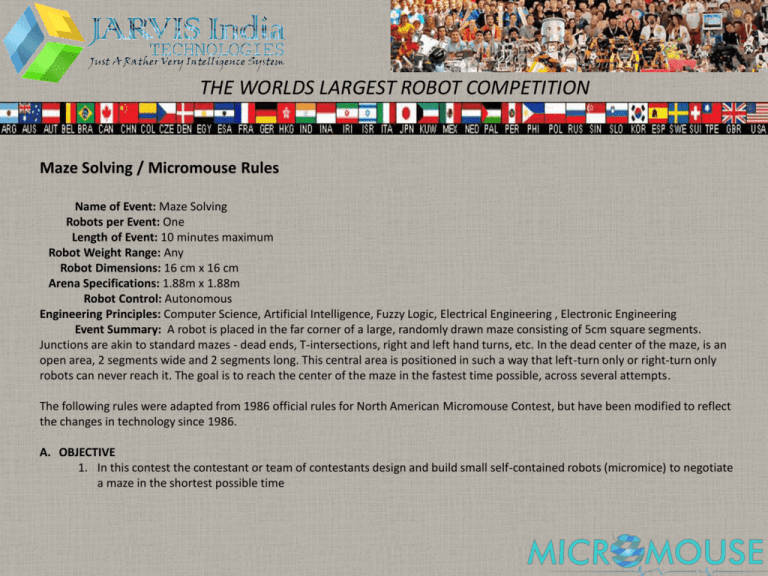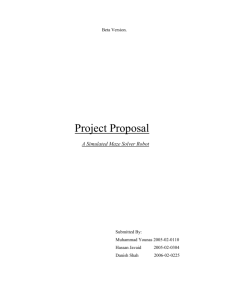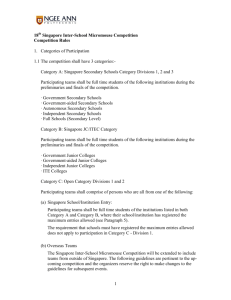Rules - Nation Flair
advertisement

THE WORLDS LARGEST ROBOT COMPETITION Maze Solving / Micromouse Rules Name of Event: Maze Solving Robots per Event: One Length of Event: 10 minutes maximum Robot Weight Range: Any Robot Dimensions: 16 cm x 16 cm Arena Specifications: 1.88m x 1.88m Robot Control: Autonomous Engineering Principles: Computer Science, Artificial Intelligence, Fuzzy Logic, Electrical Engineering , Electronic Engineering Event Summary: A robot is placed in the far corner of a large, randomly drawn maze consisting of 5cm square segments. Junctions are akin to standard mazes - dead ends, T-intersections, right and left hand turns, etc. In the dead center of the maze, is an open area, 2 segments wide and 2 segments long. This central area is positioned in such a way that left-turn only or right-turn only robots can never reach it. The goal is to reach the center of the maze in the fastest time possible, across several attempts. The following rules were adapted from 1986 official rules for North American Micromouse Contest, but have been modified to reflect the changes in technology since 1986. A. OBJECTIVE 1. In this contest the contestant or team of contestants design and build small self-contained robots (micromice) to negotiate a maze in the shortest possible time B. RULES FOR THE MicroMouse 1. A MicroMouse shall be self-contained (no remote controls). A MicroMouse shall not use an energy source employing a combustion process. 2. A MicroMouse shall not leave any part of its body behind while negotiating the maze. 3. A MicroMouse shall not jump over, fly over, climb, scratch, cut, burn, mark, damage, or destroy the walls of the maze. 4. A MicroMouse shall not be larger either in length or in width, than 16 centimeters. The dimensions of a MicroMouse that changes its geometry during a run shall not be greater than 16 cm x 16 cm. 5. Any violation of these rules will constitute immediate disqualification from the contest and ineligibility for the associated prizes. C. RULES FOR THE MAZE 1. The maze is composed of multiples of an 18 cm x 18 cm unit square. The walls of the maze are 5 cm high and 1.2 cm thick (assume 5% tolerance for mazes). Thus, the internal navigable area within a square is 16.8cm, not 18cm. The maze comprises up to 16 x 16 unit squares, for a total maze size of up to 2.88m square. The outside wall encloses the entire maze. 2. The sides of the maze walls are white, the tops of the walls are red, and the floor is black. The maze is made of wood, finished with non-gloss paint. WARNING: Do not assume the walls are consistently white, or that the tops of the walls are consistently red, or that the floor is consistently black. Fading may occur; parts from different mazes may be used. Do not assume the floor provides a given amount of friction. It is simply painted plywood and may be quite slick. There may be a seam between the two sheets on which any lowhanging parts of a robot may snag. 3. The start of the maze is located at one of the four corners. The start square is bounded on three sides by walls. The start line is located between the first and its second squares. That is, as the robot exits the corner square, the time starts. The destination goal is the four cells at the center of the maze. The destination square has only one entrance. 4. Small square zones (posts), each 1.2 cm x 1.2 cm, at the four corners of each unit square are called lattice points. The maze is so constituted that there is at least one wall at each lattice point. 5. Multiple paths to the destination square are allowed and are to be expected. The destination square will be positioned so that a wall-hugging robot will NOT be able to find it. D. RULES FOR THE CONTEST 1. Each contesting MicroMouse is not allocated any time to access the maze prior to their first run. Contestants have 10 minutes total to complete as many runs as they wish. Any time used to adjust a robot between runs is included in the 10 minutes. Each run (from the start cell to the center zone) in which a robot successfully reaches the destination square is given a run time. The minimum run time shall be the robot's official time. First prize goes to the robot with the shortest official time. Second prize to the next shortest, and so on. NOTE, again, that the 10-minute timer continues even between runs. Robots that do not enter the center square will be ranked by the maximum number of cells they consecutively transverse without being touched. All robots who enter the center square within their 10 minute allotment are ranked higher than those who do not enter the center square. If a robot is in midrun when the ten minute total time elapses, that attempt is finished and does not count. If no robots (or less that 3) finish their runs in under ten minutes, ranking will be determined by the sole discretion of the judges. Robots that do not enter the center square will be ranked by the maximum number of cells they consecutively transverse without being touched. However, judges are not required to give any rankings to robots who do not finish, and may declare no winners or declare less than 3 winners at their discretion. Two timers are used for each contestant. One for the ten-minute total time, and a separate timer for each run within the total time. 2. The initial run shall be made from a random one of the four possible starting squares. Following runs within the 10 minutes allowed shall all be from the same starting square as the first run. The operator may abort a run at any time. If an operator touches the MicroMouse during a run, it is deemed aborted, and the robot must be removed from the maze. If a robot has already crossed the finish line, it may be removed at any time without affecting the run time of that run. If a robot is placed back in the maze for another run, a one-time penalty of 30 seconds will be added to the robot's best time. 3. After the maze is disclosed, the operator shall not feed information on the maze into the MicroMouse however, switch positions may be changed for the purpose of changing programs within the robot (changing algorithms is allowed. Entering info on the maze is not allowed and does not constitute "changing algorithms.). 4. The illumination, temperature, and humidity of the room shall be those of an ambient environment. (40 to 120 degrees F, 0% to 95% humidity, non-condensing). BEWARE: Do not make any assumptions about the amount of sunlight, incandescent light, or fluorescent light that may be present at the contest site. 5. The run timer will start when front edge of the robot crosses the start line and stops when the front edge of the robot crosses the finish line. The start line is at the boundary between the starting unit square and the next unit square clockwise. The finish line is at the entrance to the destination square. 6. Every time the robot leaves the start square, a new run begins. If the robot has not entered the destination square, the previous run is aborted. For example, if a robot re-enters the start square (before entering the destination square) on a run, that run is aborted, and a new run will be deemed begun, with a new time that starts when the starting square is exited. 7. The robot may, after reaching the destination square, continue to navigate the maze, for as long as their total maze time allows. 8. If a robot continues to navigate the maze after reaching the destination square, the time taken will not count toward any run. Of course, the 10-minute timer continues to run. When the robot next leaves the start square, a new run will start. Thus, a robot may and should make several runs without being touched by the operator. It should make its own way back to the beginning to do so. 9. The judges reserve the right to ask the operator for an explanation of the MicroMouse. The judges also reserve the right to stop a run, declare disqualification, or give instructions as appropriate (e.g., if the structure of the maze is jeopardized by continuing operation of the robot). 10. A contestant may not feed information on the maze to the MicroMouse. Therefore, changing ROMs or downloading programs is NOT allowed once the maze is revealed. However, contestants are allowed to: I. Change switch settings (e.g. to change algorithms (for example from left-turning to right turning - again, entering data on maze size or content is NOT inclusive of this rule.) II. Replace batteries between runs III. Adjust sensors IV. Change speed settings V. Make repairs 11. However, a contestant may not alter a robot in a manner that alters its weight (e.g. removal of a bulky sensor array or switching to lighter batteries to get better speed after mapping the maze is not allowed). The judges shall arbitrate. 12. All robots, whether or not they have competed in previous contests, compete on an equal basis. All robots must be presented to the judges by the original design team, which must meet all other qualifications. First prize will go to that robot which travels from the start square to the destination square in the least amount of time. Second and third prizes will be awarded to the second and third fastest respectively. We ensure that you will find our training programs extremely beneficial for your students. If you have any queries kindly get back to us. We are looking forward to a quick and positive response from you and a long term association with your esteemed organization. Thanking you in anticipation of your co-operation Regards* Urvashi Agarwal Marketing Manager JARVIS INDIA TECHNOLOGIES Mob.(+91)-8744985858 Whatsapp: (+91)-901532282 urvashi@jarvisindia.com setup.workshop@gmail.com info@jarvisindia.com www.jarvisindia.com








